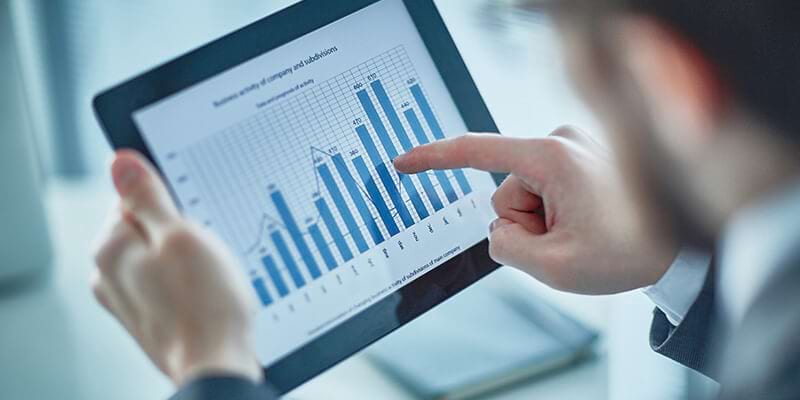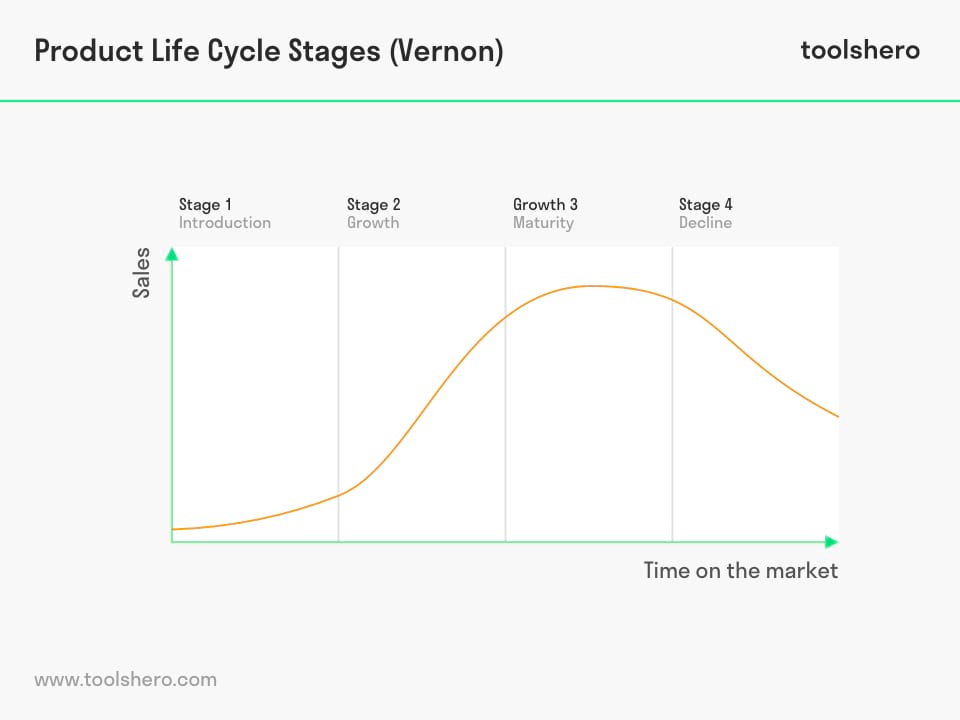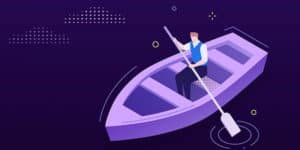Product Life Cycle Stages Theory with Examples

Product Life Cycle stages: this article explains the Product Life Cycle Stages, developed by Raymond Vernon in a practical way. Next to what the Product Life Cycle is, this article also highlights the history and an examples from practice. After reading you will understand the basics of this marketing development theory. Enjoy reading!
History of the Product Life Cycle
The Product Life Cycle Stages or International Product Life Cycle, which was developed by the economist Raymond Vernon in 1966, is still a widely used model in economics and marketing.
Products enter the market and gradually disappear again. According to Raymond Vernon, each product has a certain life cycle that begins with its development and ends with its decline.
What are the 4 phases of the product life cycle?
According to Raymond Vernon there are 4 phases in a product’s life cycle: introduction, growth, maturity and decline.
The length of a stage varies for different products, one stage may last some weeks while others even last decades. This shows that the Life Cycle is very similar to the diffusion of innovation model that was developed by Everett Rogers in 1976.
The life span of a product and how fast it goes through the entire cycle depends on for instance market demand and how marketing instruments are used.

Figure 1 – the product life cycle stages (Vernon)
Phase 1: The introduction stage
When an organization has developed a product successfully, it will be introduced into the national (and international) outlet. In order to create demand, investments are made with respect to consumer awareness and promotion of the new product in order to get sales going.
At this stage, profits are low and there are only few competitors. When more items of the product are sold, it will enter the next stage automatically.
Phase 2: The growth stage
In this stage the demand for the product increases sales. As a result, the production costs decrease and high profits are generated. The product becomes widely known, and competitors will enter the market with their own version of the product. Usually, they offer the product at a much lower sales price.
To attract as many consumers as possible, the company that developed the original product will still increase its promotional spending. When many potential new customers have bought the product, it will enter the next stage.
Phase 3: The maturity stage
In the maturity stage, the product is widely known and is bought by many consumers. Competition is intense and a company will do anything to remain a stable market leader. This is why the product is sold at record low prices.
Also, the company will start looking for other commercial opportunities such as adaptations or innovations to the product and the production of by-products.
Furthermore, consumers will also be encouraged to replace their current product with a new one. There is fear of decline of the product and therefore all the stops will be pulled out in order to boost sales. The marketing and promotion costs are therefore very high in this stage.
Phase 4: The decline stage
At some point, however, the market becomes saturated and the product is no longer sold and becomes unpopular. This stage can occur as a natural result but can also be stimulated by the introduction of new and innovative products. Despite its decline in sales, companies continue to offer the product as a service to their loyal customers so that they will not be offended.
Product Life Cycle Stages example
It is a myth that every product has to go through each of the stages. There are products that never get beyond the introduction stage, whereas other products remain in the maturity stage for a considerable length of time.
For example, the Philips light bulb was a product that found itself in the maturity stage for decades. The duration of each stage depends on demand, production costs and revenues.
Low production costs and a high demand will ensure a longer product life. When production costs are high and there is a low demand for the product, it will not be offered on the market for a long time and, eventually, it will be withdrawn from the market via the decline stage.
It’s Your Turn
What do you think? Are the Product Life Cycle Stages applicable in today’s modern economy and marketing? What kind of influence does Internet have on the Product Life Cycle Stages? Are there still four stages or are there new ones?
Share your experience and knowledge in the comments box below.
More information
- Bartlett, C. A., & Ghoshal, S. (1999). Managing across borders: The transnational solution. Harvard Business School Press.
- Jensen, R., & Thursby, M. (1986). A strategic approach to the product life cycle. Journal of International Economics, 21(3), 269-284.
- Vernon, R. (1979). The product cycle hypothesis in a new international environment. Oxford bulletin of economics and statistics, 41(4), 255-267.
- Vernon, R. & Wells, L. T. (1966). International trade and international investment in the product life cycle. Quarterly Journal of Economics, 81(2), 190-207.
How to cite this article:
Mulder, P. (2012). Product Life Cycle Stages (Vernon). Retrieved [insert date] from Toolshero: https://www.toolshero.com/marketing/product-life-cycle-stages/
Original publication date: 09/24/2012 | Last update: 04/12/2024
Add a link to this page on your website:
<a href=”https://www.toolshero.com/marketing/product-life-cycle-stages/”>Toolshero: Product Life Cycle Stages (Vernon)</a>













5 responses to “Product Life Cycle Stages Theory with Examples”
Thanks for sharing this informative article, Product life cycle plays a very important role in achieving business objectives.
Yes product life cycle stages are applicable in today life
Thank you very much for sharing this Product life cycle theory. I just clearly understand this theory.
What are the life cycle stretching strategies
This great article, explain product life cycle in simple way